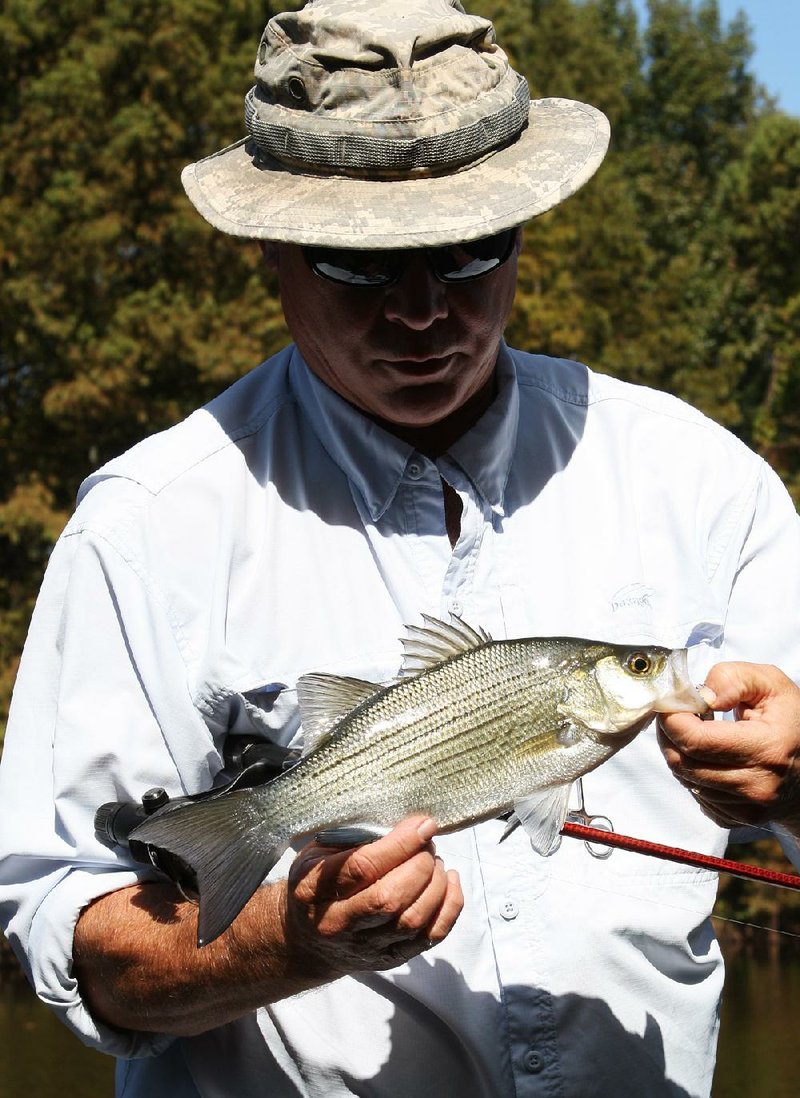LAKE ATKINS -- Autumn's Arkansas Fishing Road Show has been full of surprises, and last week's visit to this big bass hotspot did not disappoint.
Rusty Pruitt of Bryant has been my companion on this impromptu succession of day trips, and he discovered the joys of topwater fishing for schooling crappie with fly-fishing gear during a recent stop at Lake Nimrod.
Topping that for uniqueness was impossible, but fly fishing for white bass at Lake Atkins came close.
We settled on Lake Atkins after Mark Hedrick, co-host of the Ray Tucker's Arkansas Outdoors, It's A Natural radio program, texted me a photo of his son Matthew hoisting a pair of big largemouths that he caught Sunday. I wanted some of that action, and it took no cajoling to convince Pruitt to join me.
Two anglers with their assorted rods, reels, tackle, cooler and other gear is a mighty tight fit. I almost told him to leave his fly rod at home, but he has the most fun when he fly fishes. I'm glad I held my tongue.
We arrived at Lucky Landing about lunchtime as three other anglers trailered their boat to leave.
"You should have been here last week," one of them said. "It was awesome."
I could only imagine what that meant because they were finishing a day when they said they caught 15 bass in the 17- to 20-inch range.
We began fishing a line of cypress trees across the lake from Lucky's. I used a black/red flake Ribbit frog with a weighted keeper hook, which makes the frog sink. It looked great coming out of the shadows with its legs paddling the water, but I didn't get a bite.
Pruitt used a 6-weight fly rod to zing popping bugs and sinking flies called "Gee Whiz" under the branches. He didn't get any bites either.
Mystified, I called Hedrick and asked how Matthew caught his fish. Hedrick said he used a green/yellow frog without any weight.
"He tossed it as far back toward the bank as he could get and just let it sit there," Hedrick said. "If they didn't hit it then, he might give it a little twitch, and if that didn't work he walked it back like a Zara Spook.
"I've got to warn you, though, that these aren't like ordinary fish," he continued. "You've got to hit them hard and get them out of there or they'll embarrass you."
Well, now. I just happened to have a bag of green and yellow Gene Larew Floating Series frogs. Pitching into tight cover is not my strong suit, but you have to practice to get better, and there is no better place to practice than where potential rewards are high. Lake Atkins has Florida-strain largemouths in excess of 10 pounds. Anglers and fisheries biologists say it might even harbor a state-record largemouth.
While I retooled my gear, a vast eruption of surface commotion distracted us. Shad jumped out of the water all around us, and big fish slammed them on the surface. We cast various topwater plugs at them, but nothing worked until Pruitt tied a blue Vibrax inline spinnerbait to one of his spinning rigs.
He got a violent strike, but to our great surprise it was a 2-pound white bass. He caught one after another.
I called Hedrick to share the news.
"The same thing happened when we were out there," he said incredulously. "That entire side of the lake was just on fire with fish schooling. I thought it looked like whites, but Matt and I didn't know if there were any in that lake."
"Oh, they're here, all right," I said. "They're all over the place, and they're healthy."
Though tempted, I refused to fall for their siren song. I was determined to catch largemouths on the frog. I pitched it into a shady cypress pocket close to the bank and let it sit.
Now you see it, now you don't. A bass sucked the frog under as if slurping it through a straw.
I set the hook with a hard sweep to the left, but I set my drag too light. The spool spun, and the fish spit the frog.
After remedying that mistake, I tried another spot. Another bass slurped the frog.
Pitching and flipping from inside a deep-well aluminum boat is different than flipping and pitching from the high casting platform of a bass boat. It takes a high-stick delivery to place the bait, but the bigger problem is that I stood at the waterline on an even plane with the trolling motor.
I swept my rod hard to the left again and crashed it into the trolling motor. That stopped the hookset and allowed the fish to spit the frog. That happened three more times until I became apoplectic.
I kept trying, but my best casting occurred after the fish quit biting. I put that frog into impossibly tight places that should have produced strikes but none came.
Instead of frustrated, I became oddly serene. I totally immersed in the process of casting and fell into an almost zen-like quest for perfection. The catching of fish was almost an afterthought, which was a good thing because they seemed to have abandoned the cypress bank.
Meanwhile, Pruitt caught small largemouths on the other side of the boat with Zoom plastic lizards.
Then the schooling activity resumed, and he started catching white bass on his fly rod. He caught so many and they fought so hard that it caused his right arm to burn.
"You don't use that muscle very much," he said, rubbing his arm. "They're wearing me out."
It was quite entertaining to watch.
Sports on 10/11/2015

